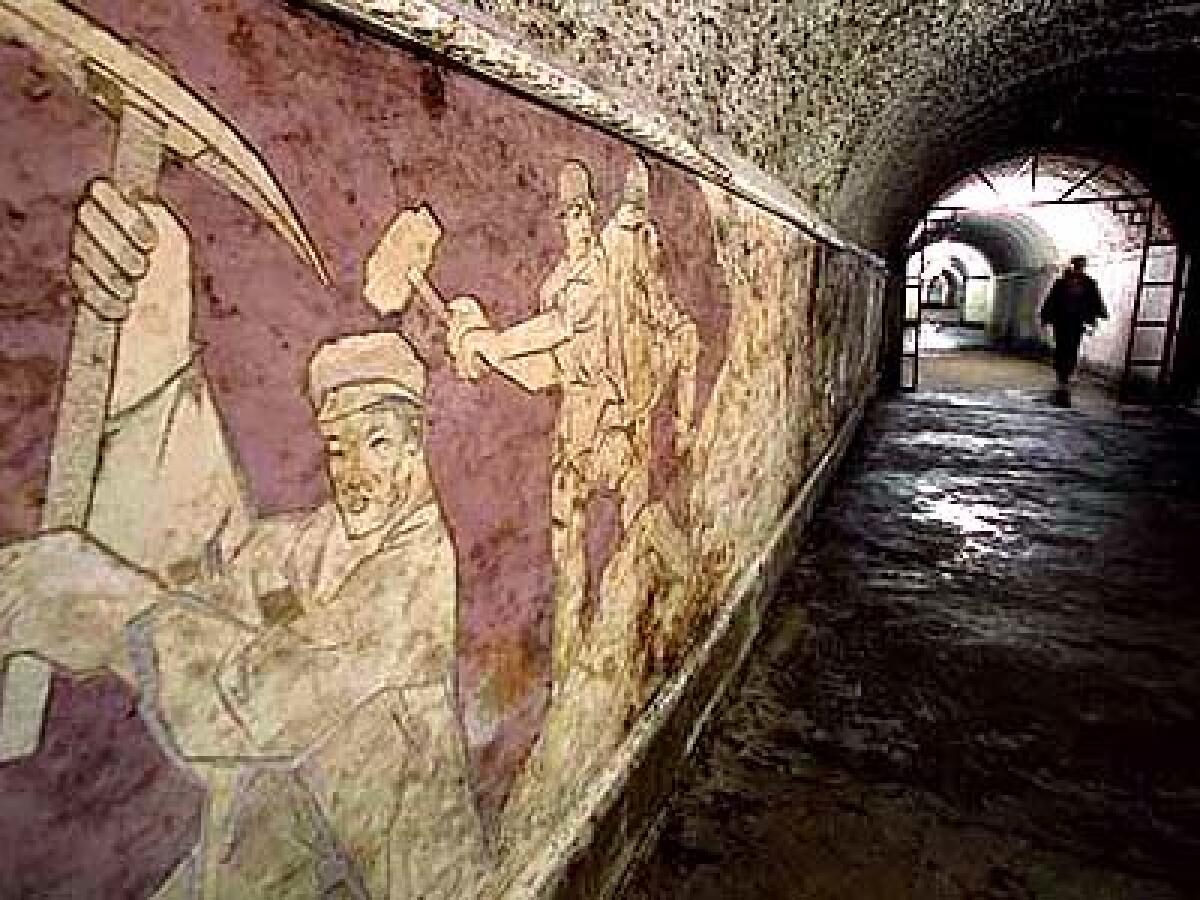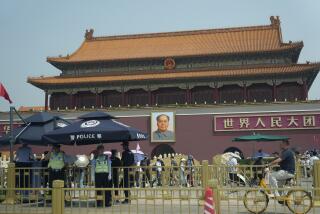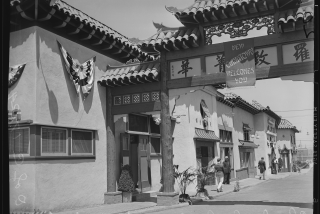Going Underground in Beijing

- Share via
BEIJING — In 1969, China’s leaders faced a problem familiar to Cold War veterans: How could they shield urban populations from military attack?
War with the Soviet Union seemed imminent. There had been skirmishes along the Siberian border. Diplomatic talks were deadlocked; nuclear weapons stood ready to be launched.
During the Cultural Revolution from 1966 to 1976, China’s Communist leaders sent the nation’s youth to the countryside to safeguard their proletarian minds from bourgeois thought. And Chairman Mao had a plan to protect proletarian bodies from Soviet bombs: Start digging, he said.
In the capital, 70,000 conscripted “volunteers” dug for a decade, creating a sinuous and unmeasured network of tunnels dubbed the “underground Great Wall.” Like the Great Wall, it has become a tourist attraction.
But a visit to the Underground City reveals more than what is below the capital’s bustling streets. It also showcases China’s history, which endures in the traditional alleyways that are being turned to rubble for the 2008 Olympics.
In 1997, after a Peace Corps stint teaching college in the Chinese countryside, I moved to Beijing to teach and write. Graduate school at UC Berkeley tore me away, but last summer I returned to visit my former students.
When they said they wanted to see something especially and ephemerally Beijing, I got to thinking. Like most residents of the capital, I had heard rumors of secret passageways beneath its sidewalks. Soldiers were said to have entered Tiananmen Square from the tunnels during the 1989 crackdown on demonstrating students.
The capital was in the throes of another massive renovation. Its old gray brick walls bore slogans reading either “New Beijing, Great Olympics” or chai--knock down, raze. What should we visit before it was renovated into oblivion?
My old neighborhood of Haidian, in the northwest university district, wasn’t merely unrecognizable since I had visited the year before; it was gone. And with it went ancient winding alleys, rows of spindly locust trees, duck and dumpling restaurants, sidewalk sweet potato vendors and grannies rolling their Rs as they chatted. In their place stood a new ring road, high-rise apartments and reminders of America: a McDonald’s, Domino’s Pizza and Starbucks.
At Haidian Book City, the emporium serving the student population, the best-selling titles reflected the city’s balancing act between its insulated past and its future as a new member of the World Trade Organization. Alongside commentaries on modernizing the capital were new guidebooks showcasing its ancient streets and way of life.
I chose two, “Old Beijing” and “A Guidebook to Alleys in Beijing,” which concentrate on the Qianmen neighborhood, where the entrance to the tunnels is. It is a working-class district cluttered with beauty salons, markets, newsstands and dozens of restaurants, sandwiched between the Forbidden City and the Temple of Heaven on the southern edge of Tiananmen Square. Qianmen, a warren of hutongs, narrow alleys that front four-sided homes, has remained physically unchanged for eight centuries. But modernization has begun to nibble at its edges, and, thanks to the Olympic make-over, soon it will be altered forever.
The next day four of my students met me at the two-story Kentucky Fried Chicken at Qianmen’s edge, the area’s most visible landmark aside from Chairman Mao’s blocky, hulking sarcophagus. The kids, macabre as teens can be, wanted to see Mao’s preserved body once more. We had gone twice last summer, so I urged them to consider the thick lines of people curving through Tiananmen Square under the searing sun. They relented at last.
We crossed Qianmen Avenue and stood at the head of Damochang Alley. It’s only a short, dusty distance down the alley to the entrance to the Underground City, but the walk filled our morning.
The deep crimson of the Forbidden City’s walls and the square’s creamy vermilion monuments gave way to gray brick homes with grass sprouting from their tiled roofs. They are among the few hutong homes in Beijing that aren’t preserved as living museums. We wound our way past two women swatting a badminton birdie, a woman shopping in silk pajamas and slippers, and a grandmother walking backward, urging her infant grandson to walk toward her. He was naked except for a red bib and tiny Nikes, and a small crowd had gathered to cheer him on.
One student asked me if scenes like this happened in America.
“I hope so,” I replied.
I wasn’t surprised when people began inviting us to take photos.
“This will all be torn down,” one resident said. “We’re not sure when, in the next couple of years maybe. We’ll be moved to new apartments outside the Fourth Ring Road.”
Her neighbor laughed. “Then we’ll have our own bathrooms!”
Which is a point often overlooked by romantics who want to preserve the old residences, many built as much as 100 years ago. Although hutongs are in a state of decay that looks charming, living in them isn’t. The cramped wood homes do not have plumbing, and residents of each block must share a pit toilet in an unheated room.
I was most interested in the homes’ peeling wood entrances, crafted with double red mahogany doors fastened together by an S-shaped clasp under a gateway of carved stone.
But my students were more interested in eating than in history. We chose a small place, Xiang Hai Canguan (Fragrant Sea Restaurant), which advertised home-style cooking. At its steps sat a steel basin filled with seven pig heads. Nearby, in another steel basin, a naked baby splashed.
Local wisdom calls for spicy food in hot weather to open the pores, so we ate cubes of cucumber slathered in vinegar, soy sauce, lajiao (hot red peppers) and garlic followed by bowls of cold Korean-style wheat noodles, topped with ice, pickled soybeans and seaweed and seasoned with sesame, cucumber slices and hot pepper.
I opened “Old Beijing” and looked for a passage to read aloud. The students groaned. “Let’s see it, not hear about it,” they pleaded.
To get to the Beijing Underground City, visitors must descend steep concrete stairs 30 feet into the cold, damp bedrock to walk a small loop in a corner of the complex. Four guides at the overstaffed entrance kiosk chatted with us in Chinese, then agreed that our group could enter alone. They warned us not to wander into the many unlighted tunnels because they were still unmapped and stretched for miles into darkness. Some tourists had been lost for days, a guide said.
Telling this to four teenagers hopped up on lajiao and caffeine was not a smart move.
“Can we buy candles near here?” one asked.
The guide frowned. “There’s not enough oxygen deep in the tunnels to allow a flame, and the smoke could choke you,” she said.
Cool. The student reluctantly offered a solution. “Do you have a flashlight we could borrow?”
The guide looked at me.
“I can watch over them,” I said reassuringly. Then I quoted Mao’s dying words to his successor, Hua Guofeng. It’s a line that always breaks the ice: “‘I rest easy knowing you assume my duties.’ Everything will be fine.”
The guide laughed and waved us down the narrow stairs, not noticing the flashlight I had tucked under my shirt.
We were the only visitors below, and my first impression was the sudden silence. Silence is the rarest commodity in bustling Beijing, and being surrounded by it in the tunnel’s clammy, chilly air was eerie. A string of bare 40-watt bulbs dangling from the round tunnel’s cement ceiling led us to the exhibit’s entrance, where the incongruous faces of Karl Marx, Friedrich Engels, Vladimir Lenin and Josef Stalin greeted us silently from posters. A rudimentary introduction and a map of the areas open to tourists hung beside them.
The Underground City was built to shelter 300,000 people temporarily and to move them to the outskirts of the city. Standing at the mouth of it, only four people abreast, it was impossible to imagine an evacuation scene. Breathing in air heavy with mildew, I was already claustrophobic. My students and I moved tentatively forward through narrow passageways--only slightly more than an arm’s length across but 7 feet high--past a row of Chinese characters chiseled in red: “Prepare for war!” Myriad tunnels spilled off the main artery, labeled with damp hand-painted signs, and some opened into vacant rooms, seeming ghost towns that were never inhabited. Other signs pointed the way to Tiananmen Square, the Forbidden City and, about 40 miles north of the city, the Great Wall.
One guide said she had been told the tunnels linked a nationwide subterranean thoroughfare nearly 5,000 miles long. Another disagreed, saying Beijing’s circuit covered only 42 miles. Whatever its length, the part of the Underground City open to tourists takes only half an hour to explore.
My students posed for photos at the mouth of the silenced cinema, a vacant school, a barbershop and an empty arsenal. Carvings in Socialist Realism style depicted the proletariat with raised fists and captions like “The American Empire will be defeated!” A ghost-white ceramic bust of Chairman Mao stared at us from a wall.
At the mouth of an unlit tunnel, I revealed the flashlight I carried, flipped it on and pointed it into the darkness. Excited, the kids cracked jokes and urged me on in an attempt to reach the Forbidden City. But after 10 disorienting minutes of creeping forward in the inky, frigid void, they pawed at my shirt and begged to turn back.
We did, following a strange glow and the sound of voices to the end of the tour route. We spilled into a large lighted room where a dozen women sat on couches sipping tea. Seeing us, they sprang into action, pulling cocoons from fish tanks and demonstrating how silk floss is constructed into cozy comforters, on sale for $100. While the cool air was good for the silkworms, it didn’t seem as nourishing to the workers, pale and padded in layers of scarves. We ascended the stairs back to Damochang Alley.
The sky had turned black from thunderclouds and slanting rain. Bicycles piloted by people shrouded in ponchos sliced through puddles, filling the air with the sound of tearing paper. Water ran in rivulets from the tile roofs, splashing onto laughing children. My eyes slowly adjusted to the light. The reflection of red lanterns shimmered on the black, luminous asphalt. It was a lovely, delicate scene, and soon it would all disappear.
Mike Meyer is finishing a memoir of his travels across China.
More to Read
Sign up for The Wild
We’ll help you find the best places to hike, bike and run, as well as the perfect silent spots for meditation and yoga.
You may occasionally receive promotional content from the Los Angeles Times.






